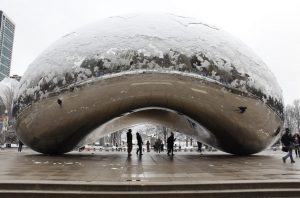Although it is connected by a large source of freshwater, the Great Lakes region faces serious water management issues, particularly from urban flooding and pipes leaking drinking water.
Stormwater and water supply infrastructure problems are common throughout the region, which is home to more than 19 million people, according to the Center for Neighborhood Technology (CNT), a Chicago-based environmental organization.
To find out the magnitude of water problems, CNT conducted surveys with Great Lakes cities, municipalities and water utility companies. The research was released to industry experts this week as part of the organization’s new Smart Water for Smart Regions initiative.
“The public really are impacted,” said Harriet Festing, director of CNT’s Water Program, who said she spoke to flood victims whose homes and basements were damaged by stormwater.
All of the cities surveyed by CNT said they have flooding problems and the majority – 80 percent of them – said the flooding complaints they receive are medium to large. Stormwater is flooding into yards, streets and parking lots (90 percent of cities surveyed); into buildings through sewer backups (83 percent); and through walls of homes and buildings (47 percent). Yet, only half of the cities – 53 percent of them – have plans in place to address flooding.
And more bad news: flooding could get worse as the region gets hit by more intense storms. The Midwest experienced a 31 percent increase in very heavy precipitation events, Festing said, recorded between 1958 and 2007. These storms are defined as the heaviest 1 percent of all daily storm events, and the trends are expected to continue to rise.
Besides sudden, sometimes severe problems from stormwater, CNT learned that a significant amount of treated drinking water is lost more slowly each year from leaks throughout the water system, which is managed by more than 100 water utility companies in the eight Great Lakes states (Illinois, Indiana, Michigan, Minnesota, New York, Ohio, Pennsylvania and Wisconsin) and Ontario, Canada.
The 55 water service providers that responded to CNT’s survey serve 500 municipalities with a population of 9.8 million people. Collectively, their water system contains 63,000 miles of pipes that are on average 50 years old. Aging water infrastructure is the second major issue CNT aims to address with its Smart Water initiative.
“Together these pipes leak an estimated 66.5 billion gallons of water each year,” Festing said.
Residents have already paid to treat the water that is leaking out – and lost – and most utility companies do not have policies to control this water loss, Festing added.
Six Chicago area communities are running test pilots for CNT’s “Wetrofit” program aimed to retrofit properties to prevent flooding and leaks, CNT staffers said. As CNT ramps up efforts in its two-year Smart Water for Smart Regions initiative, it will expand to other interested utilities and municipalities as well.
CNT will work with area communities, cities and other groups, with support from State Farm, The Joyce Foundation and the U.S. Environmental Protection Agency, to address stormwater flooding and drinking water issues in the Great Lakes region.
“We think we are water rich, but we may not be,” said Judy Beck, who works in the Great Lakes National Program office of the U.S. EPA.
Related articles
 What does the voice of the Great Lakes sound like?(greatlakesecho.org)
What does the voice of the Great Lakes sound like?(greatlakesecho.org)














Be First to Comment